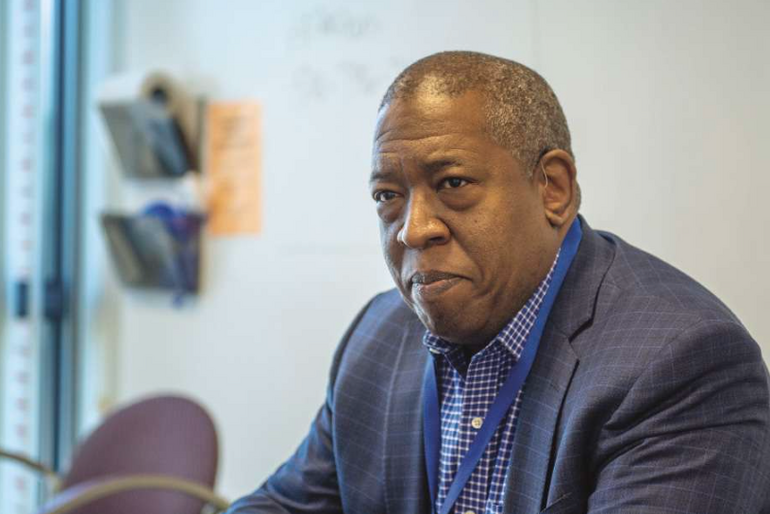Newly released data shows the majority of leadership positions in the Massachusetts healthcare industry are held by white people, a fact that not only shapes workplace dynamics, but can often lead to negative healthcare delivery and outcomes for patients.
The Center for Health Information and Analysis released the results of its inaugural Massachusetts Health Care Workforce survey in May, a report detailing staffing capacity and diversity information among 10 healthcare sectors. The survey was launched in May 2023 and fielding was completed in January.
White professionals filled 65% of leadership positions throughout all sectors, according to the CHIA survey. Black professionals were the second highest leadership demographic at 15%, followed by Asian, Native Hawaiian, or Pacific Islander (AANHPI) at 11%, and those Hispanic of any race at 9%.
This lack of diversity among healthcare providers can result in a myriad of negative patient outcomes, said Amie Shei, president and CEO of The Health Foundation of Central Massachusetts in Worcester.

“There are some kinds of implicit biases that all of us have, including providers, that sometimes lead them to provide different care to patients, depending on race, ethnicity, other factors,” Shei said. “Some of these biases, they’re not even aware of, but when you look at data you can identify some of these systematic patterns.”
These system problems include increased rates of maternal morbidity amongst Black women, said Shei. The importance of having diverse providers was further amplified during the pandemic, especially when the COVID vaccine became available, she said.
“There was a lot of vaccine hesitancy among certain communities, a lot of mistrust. And so it’s really important that the providers can relate to the population that they’re serving. That they can identify with them, identify with their culture, in some cases to be able to speak the language or have access to somebody that can help interpret,” said Shei.
These needs can be especially important when dealing with critical medical needs. That area of health care has the least diverse leadership, according to CHIA.
In fact, 93.5% of leadership positions in emergency medical services positions were held by white people, 79.5% in acute hospital care, and 74.8% in behavioral health.
On the other hand, the sectors which saw the most diversity among healthcare leadership positions were in more community-integrated healthcare organizations: adult day health, home health care, and community health centers. They were the only three sectors with more than 50% of their leadership coming from diverse populations.
In home health care, 64.7% of leadership positions were held by people of color, and the sector had the second largest percentage of Black leaders at 28.0%. For the other leaders of color, 9.8% are AANHPI; and 26.9% are Hispanic of any race.
In adult day health, 56.4% of leadership positions were held by people of color, and the sector had the largest percentage of AANHPI leaders of the 10 surveyed at 25.4%. Another 21.2% are Black; and 8.0% are Hispanic of any race.
In community health centers, 63.1% of leadership positions were held by people of color and had the most evenly-split percentages across the four races and ethnicities surveyed; 27.2% were Black; 20.5% were AANHPI; and 15.4% were Hispanic of any race.
Continuing to increase diversity among both leadership and direct providers can help mitigate the issue of lack of trust in healthcare systems many in minority groups face.
When patients don’t see healthcare systems as ones that understand their individual culture, that can lead to delayed care, said Shei. Patients can be misdiagnosed or their treatment delayed even when they’ve seeked it because they’re seeing a provider who isn’t able to understand what they’re experiencing.
Direct care workers consistently exhibited the most diversity of all the positions CHIA surveyed across all sectors, as more than half of its workforce made up of people of color.
Home health care saw the greatest percentage of people of color in direct care positions at 74.1%. Home health care was the sector with the most Black direct care workers at 47.1% and the smallest percentage of AANHPI workers at 0.7%. Hispanic of any race accounted for 26.3% of direct care employees.
In adult day health, people of color made up 52.6% of the direct care workforce; 27.8% are Hispanic of any race; 12.8% are AANHPI; and 12% are Black.
In nursing homes, people of color in direct care positions represented 51.4% of the workforce with the largest percentage identifying as Black at 33.9% followed by Hispanic of any race at 15.9% and AANHPI at 1.6%.
Though this diversity is promising to see, people in these positions need to have the ability to advance in their careers if they desire to do so, Shei said.
“There is an important opportunity to make sure that those in entry-level positions have the opportunities, professional development, mentoring, to be able to advance and rise to leadership positions,” she said.
Mica Kanner-Mascolo is a staff writer at Worcester Business Journal who primarily covers the health care and diversity, equity, and inclusion industries.

